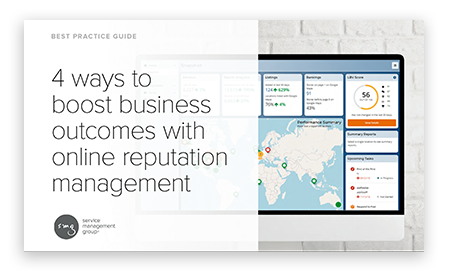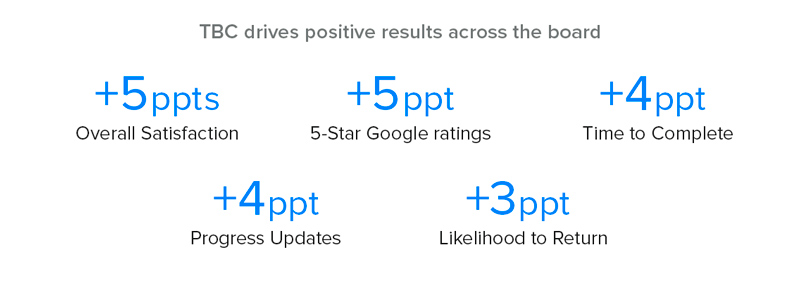Automotive Reputation Management: A Quick-Start Guide on Navigating Online Reviews
Published on Dec 07, 2022

Online reviews are a foundational part of your brand’s presence and reputation—and poor management of ratings and reviews can be especially damaging for automotive service brands. According to AutoInc., more than 90% of consumers rely on online reviews when deciding where to service their vehicle—and 88% trust online reviews just as much as personal recommendations. On top of that:
- 97% of people read reviews of local businesses
- 76% of local smartphone searches lead to an in-store visit within 24 hours
- 45% of consumers are more likely to visit a business if the brand responds to negative reviews
Obviously the stakes are high when it comes to how you manage your online presence. But when you get it right, unsolicited data can be key to understanding the entire customer experience (CX). Solicited data still has its place in your CX strategy, but relying only on this customer feedback means you’re missing out on key constituent groups such as non-purchasers and detractors.
This blog will help brands stay on top of their automotive reputation management. We’ll share tips for optimizing your brand’s responses to online reviews, what insights to look for/prioritize, and finding solutions to lock in that 5-star rating.

Optimize ratings + reviews to build stronger customer relationships
What is automotive reputation management?
Online reputation management is the active monitoring of online activity involving your brand and applying strategies to create more positive mentions and fewer negative examples of feedback. Automotive reputation management is the online reputation management of automotive brands.
Ratings + reviews management is one of the strongest ways for an automotive service brand to gain a clearer view of how they stack up against the competition, identify where immediate attention is needed, and respond to customer issues in real time. With the severe disruption the automotive industry has seen in the past few years, the competition is stiff to keep the attention of loyal customers and book more new customer service appointments.
How automotive brands can improve online ratings and reviews
It’s critical your brand shows up when your customers—or potential customers—search things like “auto services near me” or “schedule oil change.” It’s even more critical they find strong star ratings and positive reviews to back the reputation of your brand.
But how can you control your ranking and the unsolicited feedback your customers leave? Here are 3 tips to finetune your automotive reputation management strategy.
Step 1: Audit your ratings and reviews across core sites
Begin with Google—it is the #1 search engine and where the majority of feedback is coming from. Here’s what to look for:
- Are your customers able to find you? Do a quick search of your brand and check out your search engine placement.
- What are you customers saying about your brand? To get a good grasp on this, you need to dive into their feedback via Google (again, start here), Yelp, and other main social media sites
- What are you saying to your customers? Negative reviews are an opportunity for you to build a bridge. Not every bad experience will be salvageable, but you can try—and other customers will see your efforts on these sites. There’s also an opportunity to move people from 4 stars to 5. If someone had a good but not great experience, ask why!
Step 2: Knock out the easy wins
Address the low-hanging fruit for quick successes by:
- Auditing your location data. Determine where you are being ranked and how accurate your location data is. If this information is out-of-date, make changes.
- Optimizing your brand on review sites. If you haven’t already, claim your Yelp and claim your Google Business profile. Upload pictures that support your brand, make sure the contact information is correct, and check off the essentials. Also consider creating a Facebook page that feels up to date. These are places customers expect to find you and the updates will improve your search ranking + accuracy.
- Start responding to your customers. Whether their feedback is negative or positive, you need to show customers you’re listening. You can create templates to make this easier, but it should feel personal. The human-to-human connection is a place where a true service provider can stand out.
Dive deeper into the data
This part is a little trickier—and will take some time. Essentially, you’re looking at:
- Sentiment of your brand: Are customers generally happy or unhappy about their experiences? How does this vary by location?
- Trends across locations: What’s hurting or helping the customer experience? Is this something all of your locations are doing or just a few?
- Differences from solicited customer feedback: How does this unsolicited feedback compare to the solicited feedback you’re collecting from customers? Is one group happier than the other?
Now that you have the information you need to set up an online management strategy that will drive engagement, improve problem resolution, and increase customer advocacy, let’s take a look at an auto service brand that was able to successfully put this strategy into action.
Client success story: How TBC used ratings + reviews data to improve front-line communication

For more than 65 years, TBC Corporation, one of North America’s largest marketers of automotive tires, has prided itself on providing customers with quality products and services. However, the brand knew it was missing the mark on Time to Complete Service—their top driver of Overall Satisfaction but lowest-performing measure—with 1 in 4 customer complaints related to timing
of service.
With most appointments requiring a predetermined service time, TBC was looking for ways to improve speed without compromising quality of work.
Location-level data showed perception of speed was most impacted when customers chose to wait with their vehicle and scores were lowest when customers scheduled an appointment online. TBC and its SMG team also analyzed ratings + reviews data to identify specific services that were causing issues.
Further analysis revealed providing customers with progress updates helped improve speed perception and positively impacted other associate-related metrics (i.e., Knowledge of Associates + Friendliness of Associates).
The brand took action by:
- Implementing the “Say Yes” initiative, focusing on better communication with customers + expansion of appointment offerings
- Emphasizing the need for associates to provide progress updates throughout appointments, especially to customers waiting in store
The work paid off with an increase in loyalty metrics, Google star ratings, and service standard scores.

Harness the power of ratings and reviews
This is tough but essential work. And it’s the future—survey-only feedback isn’t enough and you have to modernize your approach to CX improvement. Ratings + reviews is the best way to gain a clearer view into how you stack up against the competition, what you need to do to rise to the top, and how to quantify ROI by connecting customer experience and sales growth.
SMG can help you manage ratings and reviews—and fold that data into your customer experience program. Actionable insights result from having unsolicited social ratings + reviews with solicited location-level feedback all in a single platform. Our online reputation management solution pulls all the relevant information you need from the most important sources and puts it alongside your other CX data—providing a single source of cross-channel insights.
For more information on our online reputation management solution, request a demo.
Related articles

Manage your online reputation to boost business outcomes
As of last June, 81% of Americans owned a smartphone. In the throes of this convenience revolution—as more consumers turn to their phones for research and to make purchases—the pressure for brands to

These time-saving capabilities are vital in a ratings + reviews management solution
Brands need an online reputation management system that integrates their other CX data with unsolicited ratings + reviews. But while implementing an online reputation solution is a great first step, i

How retailers can deliver excellent experiences in 2023
Brand and customer experience expectations went through big changes due to COVID-19. Here's how companies are keeping up in the new normal.